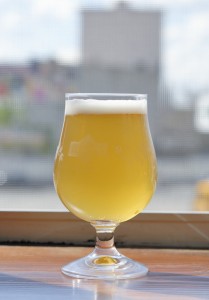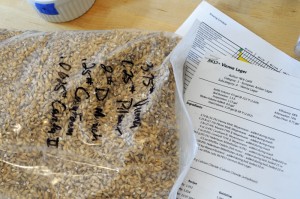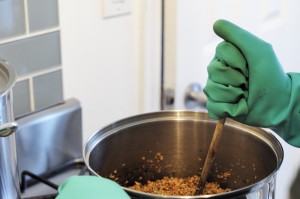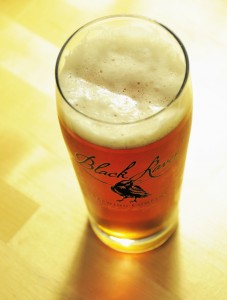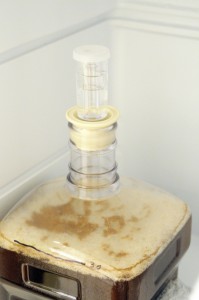Lately I’ve been drinking a lot of Firestone Walker’s Pivo Pils. This beer delivers a terrific hop punch set against a modest amount of alcohol and absolutely dry fermentation character. An immensely drinkable beer during the dog-days of summer. Firestone Walker classifies this beer as a ‘hoppy pilsner’; a short and simple sub-title, but perhaps a bit light on providing a comprehensive description of the beer. In many ways, this beer reminds me of a fresh German pils, mainly due to its austere dryness. If you take a classically lean German pils and then beef it up with late kettle and dry hopping as well as a bit firmer bittering, you’ll likely get pretty close to the character of Pivo.
Intrigued by Pivo, I set out to design a beer that captures this malt character, and then use it as a platform for testing out a couple of different German hop varieties. With a little research from Firestone Walker’s website, and an interview with Matt Brynildson during a podcast on The Brewing Network, a few key recipe spec’s could be ascertained:
Original Gravity: 1.048 SG (calculated from terminal gravity and ABV)
Terminal Gravity: 1.005 SG (from TBN podcast)
Attenuation: 88% (calculated)
Alcohol: 5.3% ABV (from Firestone Walker website)
Bitterness: 40 IBU (from Firestone Walker website)
Color: 4 SRM
Other Key Points:
- 6 week turn-around time (from TBN podcast)
- 100% Weyermann malts (from TBN podcast)
- Mash Regiment: 122° > 145° > 155° > 168° (from TBN podcast)
- Calcium Chloride water treatment (from TBN podcast)
- Wyeast 2124 yeast (from TBN podcast)
- Magnum bittering (from TBN podcast)
- Spalter Select mid-boil addition (from TBN podcast)
- Saphir dry hop (from TBN podcast)
With these details in mind, I set out to formulate a recipe that captures the spirit of Pivo Pils. I selected two German hop varieties which symbolically depict the tradition of German hop growing and the direction it may be heading. Hallertau Mittelfruher is about a classic as it gets in the German brewing world, where-as Mandarina Bavaria is a new cultivar bred by the Hop Research Institute in Hull which has a Cascade hop lineage and is described as having tangerine and mandarin orange characteristics.
In determining the bittering levels for each beer, I used the Hallerau Mittelfruher beer as my base, and then scaled down the amount of hops used on the hot-side of the Mandarina Bavaria beer to achieve a comparable amount of hop bitterness.
SMaSH Hallertau Mittelfruher / Pilsner Recipe
Recipe Specifications:
Size: 3.25 gal
Efficiency: 68%
Attenuation: 88%
Original Gravity: 1.048 SG
Terminal Gravity: 1.006 SG
Color: 4.26 SRM
Alcohol: 5.53% ABV
Bitterness: 28.0 IBU (does not take into account bitterness achieved during whirlpool)
Grist:
6.75 lb (100.0%) Weyermann Pilsner Malt
Water Treatment added to Strike Water:
Soft NYC Water
4g Calcium Chloride
1g Gypsum
Mash Regiment:
0m – 122° F – Mash in at 122° F and immediately ramp up to next step
50m – 145° F – Beta Amylase Rest
10m – 155° F – Alpha Amylase Rest
5m – 168° F – Mash Out
Hopping:
60m – 20 g Hallertauer Mittelfrüher (4% AA)
30m – 20 g Hallertauer Mittelfrüher (4% AA)
Whirlpool 20m – 80g Hallertauer Mittelfrüher (4% AA)
Dryhop 3 Days – 26 g Hallertauer Mittelfrüher (4% AA)
Kettle Additions:
15m – 0.5 ea Whirlfloc Tablet
10m – 0.5 tsp Wyeast Nutrient
Yeast:
White Labs WLP833 German Bock Lager – 1400ml starter on stir plate
Fermentation:
1. Chill to 46° F and let rise to 48° F
2. Ramp temperature as fermentation slows up to 58° F for diacetyl rest
3. Crash to 32° F
4. Keg and lager at 32° F for 4 weeks.
SMaSH Mandarina Bavaria / Pilsner Recipe
Recipe Specifications:
Size: 3.25 gal
Efficiency: 68%
Attenuation: 88%
Original Gravity: 1.048 SG
Terminal Gravity: 1.006 SG
Color: 4.26 SRM
Alcohol: 5.53% ABV
Bitterness: 28.0 IBU (does not take into account bitterness achieved during whirlpool)
Grist:
6.75 lb (100.0%) Weyermann Pilsner Malt
Water Treatment added to Strike Water:
Soft NYC Water
4g Calcium Chloride
1g Gypsum
Mash Regiment:
0m – 122° F – Mash in at 122° F and immediately ramp up to next step
50m – 145° F – Beta Amylase Rest
10m – 155° F – Alpha Amylase Rest
5m – 168° F – Mash Out
Hopping:
60m – 12 g Mandarina Bavaria (7.2% AA)
30m – 12 g Mandarina Bavaria (7.2% AA)
Whirlpool 20m – 44 g Mandarina Bavaria (7.2% AA)
Dryhop 3 Days – 26 g Mandarina Bavaria (7.2% AA)
Kettle Additions:
15m – 0.5 ea Whirlfloc Tablet
10m – 0.5 tsp Wyeast Nutrient
Yeast:
White Labs WLP833 German Bock Lager– 1400ml starter on stir plate
Fermentation:
1. Chill to 46° F and let rise to 48° F
2. Ramp temperature as fermentation slows up to 58° F for diacetyl rest
3. Crash to 32° F
4. Keg and lager at 32° F for 4 weeks.

